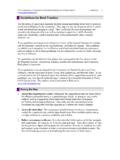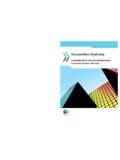Transcription of Motor Vehicle And Fleet Management Best Practice …
1 Mississippi Board of Trustees of State Institutions of Higher Learning Motor Vehicle And Fleet Management best Practice guidelines Office of Risk Management Safety and Loss Control Motor Vehicle and Fleet Management best Practice guidelines 2 Contents 4 Statement of Purpose Application Enforcement/Consequences General Motor Pool Departmental Individually Assigned Combination Risk Liability Coverage Injured Employee University Vehicle Accident Reports Use Usage and Cost Recordkeeping Fuel Appearance Marking Title/License Plate Maintenance Inspection State Inspection Emergency Equipment Vehicle Modifications Authorized Drivers Driver Qualifications Driver Records Driver Training Motor Vehicle and Fleet Management best Practice guidelines 3 Contents 7 State and Federal Law Occupant Safety Distractions Impaired Driving Safe and Courteous Operation Parking/Backing Damaged/Malfunctioning Vehicle Specialty Vehicles and 8 Emergency Vehicles Special Apparatus/ Vehicle Vans Mass Transit Vehicles Commercial Vehicle Class of License and Endorsements Chartered Rental In State Out of State Privately Owned Authorization Insurance Expense Safety 12-27 A.
2 Sample Business Use Agreement B. Sample Privately Owned Vehicles Used for Business Purposes Agreement C. Sample Rental Vehicle Policy Acknowledgement D. Motor Vehicle Incident Reporting Instructions for Drivers E. Factors to be Considered During an Incident Review F. Sample Driver s Pre-Trip Inspection Checklist G. Mississippi Department of Public Safety Driver Records Request H. Van Safety Recommendations I. Guide to Hiring Bus Companies Motor Vehicle and Fleet Management best Practice guidelines 4 This guide contains the basic elements that should be addressed by each university concerning the safe and legal use of vehicles operated by the university, whether they are university owned, rented, or privately owned. The use of this guide will facilitate continuity across the IHL System with regard to elements addressed while allowing flexibility among member institutions as to how each element is addressed. The following elements are reflective of various state and federal laws and regulations, insurance industry standards, and safety standards.
3 The following practices are designed to apply to Motor vehicles that are licensed to operate on public roadways and the drivers of such vehicles, in compliance with IHL Board Policy 9 General Statement of Purpose: Explain that policies and/or procedures exist to promote the safe, legal, and responsible use of vehicles owned or operated for the benefit of the university. The protection of life, property, and the good stewardship of public resources is at stake. Application: These practices apply to any and all vehicles used for the benefit of the university that are licensed for travel on public roads. Enforcement/Consequences: Describe who will be responsible for enforcing practices and who has the authority to apply consequences for non-compliance, and outline examples of possible consequences. Consider specifically violations of rules that result in a threat to life, violations of law, and violations resulting in collision or injury. 9 Management General: Senior leadership should endorse the overall Vehicle operations and Fleet Management program.
4 Focus should be given to the safety of employees, students, and the public. Benefits of a comprehensive program include wise stewardship of public resources, a good public image, conservation of budget, and responsibility to citizens. With consideration given to how vehicles are allotted, assigned, or managed, all levels of Management should be involved in and held accountable for the program s development, Management , and implementation. If Motor Pool: Define guidelines for acquiring and returning vehicles. Also include responsibilities of Motor pool with regard to appearance, maintenance, repair, recordkeeping, and inspections. If Departmental: Appoint a departmental coordinator or liaison responsible for appearance, assignment, maintenance, repair, recordkeeping, and inspections. If Individually Assigned: Define responsibilities regarding appearance, maintenance, repair, recordkeeping, and inspections. If Combination of Above: Provide information on each form of Management as related to accountability.
5 9 Risk Management Liability Coverage: Explain auto liability coverage. Ensure accurate and current proof of coverage cards are kept in every Vehicle . The MS Tort Claims Act provides protection and is exclusive remedy only while the automobile is used within the scope and course of one s duties for the university. Within Mississippi, the limit is $500, per occurrence. Out of state, other state laws apply. Motor Vehicle and Fleet Management best Practice guidelines 5 Injured Employee: Explain Workers Compensation coverage. Workers Compensation will apply as exclusive remedy to employees injured in a Vehicle collision while engaged in the course and scope of one s duties for the university. University Vehicle : Explain the university policy regarding repair or replacement of damaged vehicles. Property and budget issues should be disclosed. If the other party was at fault, a claim against their insurance should be pursued. Accident Reports: Complete and accurate information must be reported to the appropriate insurance agent immediately.
6 Provide a sample of the form to be used and detail who should initiate the report and how the report should be distributed. Explain the consequences of failing to report accidents on a timely basis. 9 Vehicles Use: Explain authorized use and misuse. Limit operation of each Vehicle to the intended use within the capacities as described by the manufacturer. Provide an avenue to match the Vehicle to the job that needs to be performed. MS Code 25-1-79 states that it is unlawful to use a university-owned Vehicle for anything other than official business of the university. Usage and Cost Recordkeeping: Explain mileage, destination, and driver recordkeeping requirements. Also explain maintenance, repair, operation cost, and other recordkeeping requirements. Fuel: Describe the procedure for acquiring fuel on and off campus. Explain rules regarding usage, recordkeeping, and purchasing. Explain the federal excise tax exemption and budgetary implications. Appearance: Explain the university s policy regarding its public image.
7 Address issues such as cleanliness, repairs, and conditions which are unacceptable for operation. Marking: Provide information regarding requirements for the marking of university-owned vehicles in compliance with MS Code 25-1-87. Identify who is responsible for ensuring that vehicles are properly marked and explain how to have vehicles marked properly. Title/License Plate: Explain how titles/license plates are acquired, who acquires them, and where they are kept for future reference. Include procedures for the transfer of titles during disposal of vehicles. Maintenance: Identify maintenance schedules for various types of vehicles that are within the manufactures recommendations. Define who is responsible for adhering to the schedule and identify what records should be kept. Identify the qualifications needed by personnel authorized to perform maintenance. Provide procedures for responding to recall notices. Explain purchasing authority and limitations or other related financial details.
8 Inspection: Describe university protocol regarding periodic safety inspections on various types of vehicles. Include pre-trip (driver), weekly, monthly, quarterly, and annual inspections as necessary. Provide forms to ensure adequate and consistent inspections. Identify who will perform which inspections. Explain what to do in the case of exception items. Explain what documentation is required. Require annual state inspections, and provide procedures for renewing each Vehicle s windshield sticker. State Inspection Identify the procedure for renewing each Vehicle s state Motor Vehicle and Fleet Management best Practice guidelines 6 inspection sticker. Encourage drivers to notify the proper person if they notice an out-of-date sticker. Emergency Equipment: Vehicles should be equipped with appropriate emergency equipment for use in the event of mechanical failure, crash, or other circumstance that results in a disabled Vehicle near the roadway. List items to be included, such as warning triangles, first aid kit, fire extinguisher, and other equipment depending on Vehicle type and use.
9 Vehicle Modifications: Describe university policy regarding modifications made to university-owned vehicles. Ensure that no modifications create an unsafe condition or disable/circumvent any safety device. Designate personnel authorized to perform modifications. Consider such things as: radio equipment, towing equipment, security devices, material handling needs, and navigational devices. 9 Drivers Authorized Drivers: Explain the university process to become an authorized driver. Identify personnel with the authority to authorize drivers. Provide a method to document the authorization of each driver. Consider employee job descriptions that include driving as a job task. MS Code 25-1-79 states that it is unlawful to permit or authorize the use of any university-owned Vehicle for anything other than official university business. It is recommended that the university not authorize non-employees as drivers of university-owned vehicles. Driver Qualifications: University policies and procedures should address the following: 1.
10 Employees must have a valid Mississippi driver s license, or a valid driver s license from a contiguous state (MS Code 25-9-153). 2. Other authorized drivers must have a valid driver s license issued in the state or country of residency. An International Driver s Permit from the country of residence must also be required of drivers possessing a valid license from another country. Likewise, university personnel traveling abroad should obtain an International Driver s Permit prior to travel. 3. All drivers licenses must be of the appropriate classification and have any required endorsements needed for operating the Vehicle (s) assigned. 4. Driver selection must include assessment to ensure drivers are mentally and physically capable of the safe operation of the Vehicle (s) assigned. 5. Required experience should be established. One example is to require drivers to have held a driver s license for at least 3 years. Increase required experience as the complexity of the Vehicle (s) or the value of the Vehicle (s) at risk increases.









